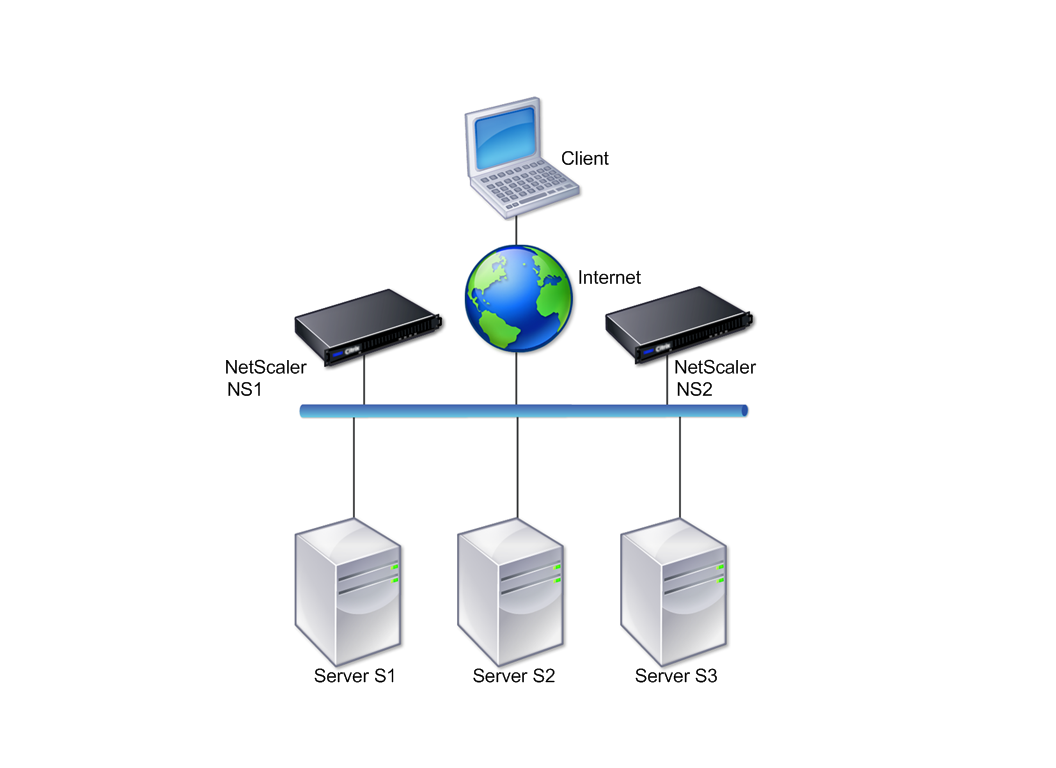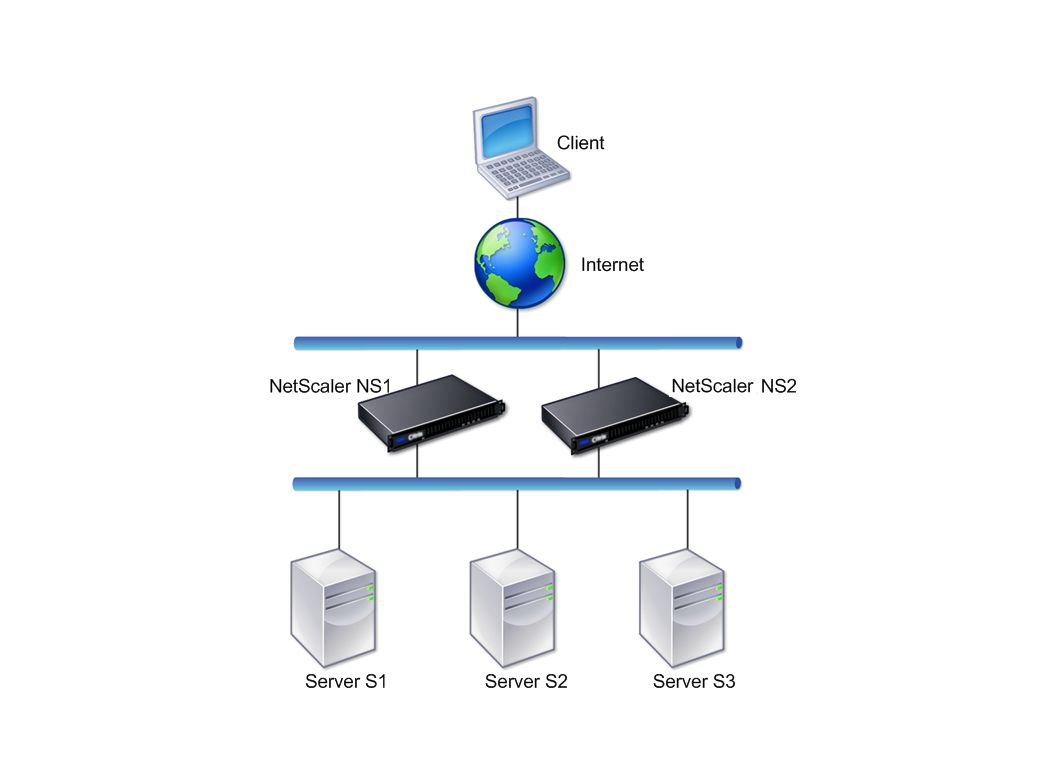-
Getting Started with NetScaler
-
Configure high availability
-
Solutions for Telecom Service Providers
-
Load Balance Control-Plane Traffic that is based on Diameter, SIP, and SMPP Protocols
-
Provide Subscriber Load Distribution Using GSLB Across Core-Networks of a Telecom Service Provider
-
Authentication, authorization, and auditing application traffic
-
Basic components of authentication, authorization, and auditing configuration
-
Web Application Firewall protection for VPN virtual servers and authentication virtual servers
-
On-premises NetScaler Gateway as an identity provider to Citrix Cloud™
-
Authentication, authorization, and auditing configuration for commonly used protocols
-
Troubleshoot authentication and authorization related issues
-
-
-
-
-
-
Persistence and persistent connections
-
Advanced load balancing settings
-
Gradually stepping up the load on a new service with virtual server–level slow start
-
Protect applications on protected servers against traffic surges
-
Retrieve location details from user IP address using geolocation database
-
Use source IP address of the client when connecting to the server
-
Use client source IP address for backend communication in a v4-v6 load balancing configuration
-
Set a limit on number of requests per connection to the server
-
Configure automatic state transition based on percentage health of bound services
-
-
Use case 2: Configure rule based persistence based on a name-value pair in a TCP byte stream
-
Use case 3: Configure load balancing in direct server return mode
-
Use case 6: Configure load balancing in DSR mode for IPv6 networks by using the TOS field
-
Use case 7: Configure load balancing in DSR mode by using IP Over IP
-
Use case 10: Load balancing of intrusion detection system servers
-
Use case 11: Isolating network traffic using listen policies
-
Use case 12: Configure Citrix Virtual Desktops for load balancing
-
Use case 13: Configure Citrix Virtual Apps and Desktops for load balancing
-
Use case 14: ShareFile wizard for load balancing Citrix ShareFile
-
Use case 15: Configure layer 4 load balancing on the NetScaler appliance
-
-
-
-
Authentication and authorization for System Users
-
-
Configuring a CloudBridge Connector Tunnel between two Datacenters
-
Configuring CloudBridge Connector between Datacenter and AWS Cloud
-
Configuring a CloudBridge Connector Tunnel Between a Datacenter and Azure Cloud
-
Configuring CloudBridge Connector Tunnel between Datacenter and SoftLayer Enterprise Cloud
-
Configuring a CloudBridge Connector Tunnel Between a NetScaler Appliance and Cisco IOS Device
-
CloudBridge Connector Tunnel Diagnostics and Troubleshooting
This content has been machine translated dynamically.
Dieser Inhalt ist eine maschinelle Übersetzung, die dynamisch erstellt wurde. (Haftungsausschluss)
Cet article a été traduit automatiquement de manière dynamique. (Clause de non responsabilité)
Este artículo lo ha traducido una máquina de forma dinámica. (Aviso legal)
此内容已经过机器动态翻译。 放弃
このコンテンツは動的に機械翻訳されています。免責事項
이 콘텐츠는 동적으로 기계 번역되었습니다. 책임 부인
Este texto foi traduzido automaticamente. (Aviso legal)
Questo contenuto è stato tradotto dinamicamente con traduzione automatica.(Esclusione di responsabilità))
This article has been machine translated.
Dieser Artikel wurde maschinell übersetzt. (Haftungsausschluss)
Ce article a été traduit automatiquement. (Clause de non responsabilité)
Este artículo ha sido traducido automáticamente. (Aviso legal)
この記事は機械翻訳されています.免責事項
이 기사는 기계 번역되었습니다.책임 부인
Este artigo foi traduzido automaticamente.(Aviso legal)
这篇文章已经过机器翻译.放弃
Questo articolo è stato tradotto automaticamente.(Esclusione di responsabilità))
Translation failed!
Configure high availability
You can deploy two NetScaler appliances in a high availability configuration, where one unit actively accepts connections and manages servers while the secondary unit monitors the first. The NetScaler appliance that is actively accepting connections and managing the servers is called a primary unit and the other one is called a secondary unit in a high availability configuration. If there is a failure in the primary unit, the secondary unit becomes the primary and begins actively accepting connections.
Each NetScaler appliance in a high availability pair monitors the other by sending periodic messages, called heartbeat messages or health checks, to determine the health or state of the peer node. If a health check for a primary unit fails, the secondary unit retries the connection for a specific time period. For more information about high availability, see High Availability. If a retry does not succeed by the end of the specified time period, the secondary unit takes over for the primary unit in a process called failover. The following figure shows two high availability configurations, one in one-arm mode and the other in two-arm mode.
Figure 1. High availability in one-arm mode

Figure 2. High availability in two-arm mode

In one-arm configuration, both NS1 and NS2 and servers S1, S2, and S3 are connected to the switch.
In two-arm configuration, both NS1 and NS2 are connected to two switches. The servers S1, S2, and S3 are connected to the second switch. The traffic between client and the servers passes through either NS1 or NS2.
To set up a high availability environment, configure one ADC appliance as primary and another as secondary. Perform the following tasks on each of the ADC appliances:
- Add a node.
- Disable high availability monitoring for unused interfaces.
Add a Node
A node is a logical representation of a peer NetScaler appliance. It identifies the peer unit by ID and NSIP. An appliance uses these parameters to communicate with the peer and track its state. When you add a node, the primary and secondary units exchange heartbeat messages asynchronously. The node ID is an integer that must not be greater than 64.
Through CLI
To add a node by using the command line interface, follow these steps:
At the command prompt, type the following commands to add a node and verify that the node has been added:
-
add HA node <id> <IPAddress>
-
show HA node <id>
Example
add HA node 0 10.102.29.170 Done > show HA node 0 1) Node ID: 0 IP: 10.102.29.200 (NS200) Node State: UP Master State: Primary SSL Card Status: UP Hello Interval: 200 msecs Dead Interval: 3 secs Node in this Master State for: 1:0:41:50 (days:hrs:min:sec) <!--NeedCopy-->
Through GUI
To add a node by using the GUI, follow these steps:
- Navigate to System > High Availability.
- Click Add on the Nodes tab.
- On the Create HA Node page, in the Remote Node IP Address text box, type the NSIP Address (for example, 10.102.29.170) of the remote node.
- Ensure that the Configure remote system to participate in High Availability setup check box is selected. Provide the login credentials of the remote node in the text boxes under Remote System Login Credentials.
- Select the Turn off HA monitor on interfaces/channels that are down check box to disable the HA monitor on interfaces that are down.
Verify that the node you added appears in the list of nodes in the Nodes tab.
Disable high availability monitoring for unused interfaces
The high availability monitor is a virtual entity that monitors an interface. You must disable the monitor for interfaces that are not connected or being used for traffic. When the monitor is enabled on an interface whose status is DOWN, the state of the node becomes NOT UP. In a high availability configuration, a primary node entering a NOT UP state might cause a high availability failover. An interface is marked DOWN under the following conditions:
- The interface is not connected
- The interface is not working properly
- The cable connecting the interface is not working properly
Through CLI
To disable the high availability monitor for an unused interface by using the command line interface, follow these steps:
At the command prompt, type the following commands to disable the high availability monitor for an unused interface and verify that it is disabled:
- set interface <id> -haMonitor OFF
-
show interface <id>
Example
> set interface 1/8 -haMonitor OFF Done > show interface 1/8 Interface 1/8 (Gig Ethernet 10/100/1000 MBits) #2 flags=0x4000 <ENABLED, DOWN, down, autoneg, 802.1q> MTU=1514, native vlan=1, MAC=00:d0:68:15:fd:3d, downtime 238h55m44s Requested: media AUTO, speed AUTO, duplex AUTO, fctl OFF, throughput 0 RX: Pkts(0) Bytes(0) Errs(0) Drops(0) Stalls(0) TX: Pkts(0) Bytes(0) Errs(0) Drops(0) Stalls(0) NIC: InDisc(0) OutDisc(0) Fctls(0) Stalls(0) Hangs(0) Muted(0) Bandwidth thresholds are not set. <!--NeedCopy-->When the high availability monitor is disabled for an unused interface, the output of the show interface command for that interface does not include “HAMON.”
Through GUI
To disable the high availability monitor for unused interfaces by using the GUI, follow these steps:
- Navigate to System > Network > Interfaces.
- Select the interface for which the monitor must be disabled.
- Click Open. The Modify Interface dialog box appears.
- In HA Monitoring, select the OFF option.
- Click OK.
- Verify that, when the interface is selected, “HA Monitoring: OFF” appears in the details at the bottom of the page.
Share
Share
This Preview product documentation is Cloud Software Group Confidential.
You agree to hold this documentation confidential pursuant to the terms of your Cloud Software Group Beta/Tech Preview Agreement.
The development, release and timing of any features or functionality described in the Preview documentation remains at our sole discretion and are subject to change without notice or consultation.
The documentation is for informational purposes only and is not a commitment, promise or legal obligation to deliver any material, code or functionality and should not be relied upon in making Cloud Software Group product purchase decisions.
If you do not agree, select I DO NOT AGREE to exit.